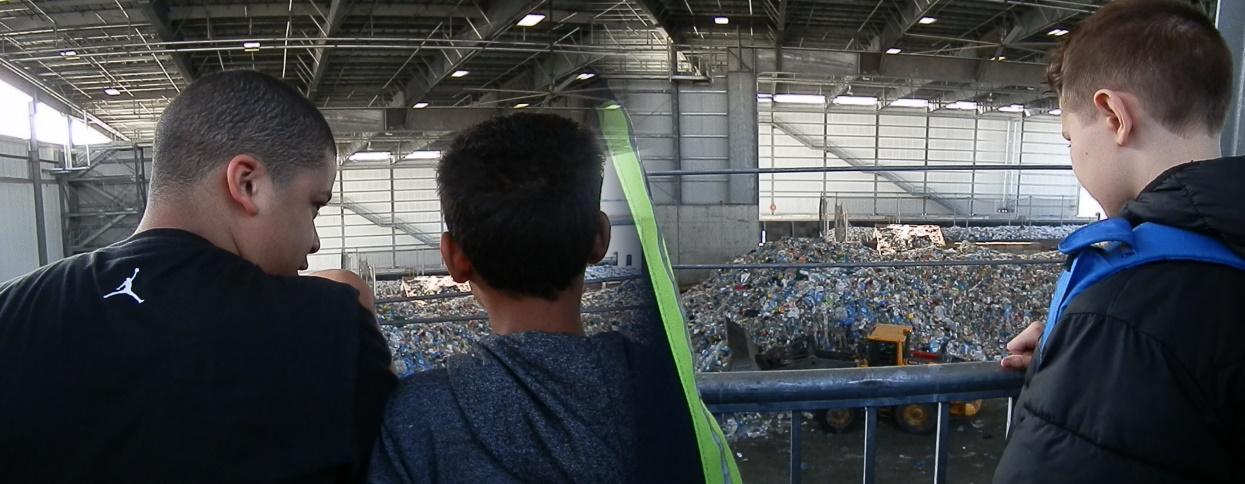One Person’s Trash Is Not Another Person’s Treasure
By Fai Walker, Greenpoint Eco-Schools Sustainability Coach @ MS 126
During NYC schools’ mid-winter break, sixteen students from MS 126 in Greenpoint Brooklyn, two committed parents, and one very creative science teacher, Steven House, spent four days exploring the Eco-Schools Pathway to Sustainability, Consumption and Waste in Brooklyn as part of a STEM Enrichment field trip series.
The classes’ first task: to understand the life cycle of the stuff we consume from start to finish, including extraction (of the natural resource), processing, manufacturing, production, distribution, consumption, and disposal. The second task: to identify the natural resources used to make to the stuff we throw away. The third task: visit the places in the city responsible for processing and removing our waste.
During the first field trip, the class visited SIMS Municipal Recycling Facility in Sunset Park, to follow the journey of discarded aluminum cans, glass bottles, plastics containers, milk and juice cartons, newspaper, cardboard boxes, and foil. Students toured the facility holding their noses, and watched as huge machines, conveyor belts, and people separated and re-sorted NYC residents’ waste. From an overhead catwalk positioned to look down at the inner workings of SIMS, students witnessed part of the processes that turned glass and plastics into pellets or crushed aluminum cans and flattened and bundled stacks of cardboard and newspapers. Inside the SIMS Education Center, students were surprised to learn that plastic can be turned into toilet tissue and other innovative ways waste can find a new life in recycled and upcycled products.

Back in their school classroom, students considered the natural resources saved and the earth not plundered when consumption is reduced or waste is recycled instead of ending up in a landfill.
But what about cellphones, transistor radios, tape recorders, word processors, televisions, walkmen, or video players?…. What happens to them? To find the answer to this question, students researched and learned about the landfills in South Carolina, Ohio, and Pennsylvania that NYC pays to take electronic e-waste. They also learned about the landfills in Africa, China, and India, where 85% of our e-waste ends up. At these sites, locals scavenge heaps of rubbish looking for e-waste that contains gold, silver, platinum, and copper. The scrap heaps are burned to dislodge the metals and cancer-causing heavy metals are released into the atmosphere. Thousands of people, many of them children who earn a living in those countries working as rubbish collectors, breathe in the toxic fumes. The groundwater and the surrounding earth itself are also contaminated. It’s an alarming reality and students wanted to know how they can contribute to solutions and change this scenario.
Therefore, their second field trip took them to Gowanus E-Waste Warehouse. Gowanus Warehouse is New York City’s only free, permanent e-waste drop-off facility, where you can leave all varieties of consumer electronics and be certain that they will not end up in the backyard of another state or continent. The Warehouse repairs, re-sells, recycles, and upcycles household electronics in an environmentally and socially responsible way.

Stepping into the Warehouse is like stepping in your grandparent’s basement—a genuine archeological dig, a glimpse into how our technology has changed over time.
“What is that?,“ one student ask as he stands before a well -crafted wooden box, the size of a small suitcase. The other boys gather round to investigate. “Look at this,” and heads spin around and everyone starts to laugh. “Oh, snap — that’s got to be older than time!” It’s a black zinc rotary style telephone with metal finger dial, the kind people used when they actually knew each other’s phone numbers. “These are ancient artifacts!,” exclaims one student.
Eager to learn and eager to be part of the solution, the students spent the better part of the morning testing an assortment of computer keyboards to determine which ones can be resold, which ones can be sold for parts, and which ones will be upcycled into art, jewelry, or other items. As one student so aptly put it, “I think of all of the oil that is used to make plastic, and the plastic is used to make our electronics, but I never think about the metals.” With experiences like these, students are able to think critically, to brainstorm solutions, and to design and engineer new solutions.
The students visited The New York Hall of Science in Queens for their third field trip. They watched, Dream Big, a 3D movie about engineering and design that shows how engineers work to create a better world and a more sustainable future. Inspired by the stories of human imagination, one student sums of the week of Consumption and Waste exploration and concludes, “You never know who could come up with a solution to ending waste.”



